Assessment of GF-3 Polarimetric SAR Data for Physical Scattering Mechanism Analysis and Terrain Classification
Abstract
:1. Introduction
2. The Co-Polarization Ratio-Based Parameters and the Diagram
2.1. Parameters in the Reflection Symmetric Case
2.2. Parameters in the Reflection Asymmetric Case
2.3. The Scattering Mechanism Classification Diagram
3. Experiments
4. Conclusions
Acknowledgments
Author Contributions
Conflicts of Interest
References
- Wang, T.; Zhang, G.; Yu, L.; Zhao, R.; Deng, M.; Xu, K. Multi-mode GF-3 satellite image geometric accuracy verification using the RPC model. Sensors 2017, 17, 2005. [Google Scholar] [CrossRef] [PubMed]
- Yang, J.; Wang, J.; Ren, L. The first quantitative remote sensing of ocean internal waves by Chinese GF-3 SAR satellite. Acta Oceanol. Sin. 2017, 36, 118. [Google Scholar] [CrossRef]
- Pan, Z.; Liu, L.; Qiu, X.; Lei, B. Fast vessel detection in Gaofen-3 SAR images with ultrafine strip-map mode. Sensors 2017, 17, 1578. [Google Scholar] [CrossRef] [PubMed]
- Wang, Y.; Wang, C.; Zhang, H. Integrating H-A-α with fully convolutional networks for fully PolSAR classification. In Proceedings of the 2017 International Workshop on Remote Sensing with Intelligent Processing (RSIP), Shanghai, China, 18–21 May 2017. [Google Scholar]
- Touzi, R. Target scattering decomposition in terms of roll-invariant target parameters. IEEE Trans. Geosci. Remote Sens. 2007, 45, 73–84. [Google Scholar] [CrossRef]
- Cloude, S.R.; Pottier, E. An entropy based classification scheme for land applications of polarimetric SAR. IEEE Trans. Geosci. Remote Sens. 1997, 35, 68–78. [Google Scholar] [CrossRef]
- Freeman, A.; Durden, S. A three-component scattering model for polarimetric SAR data. IEEE Trans. Geosci. Remote Sens. 1998, 36, 963–973. [Google Scholar] [CrossRef]
- Freeman, A. Fitting a two-component scattering model to polarimetric SAR data from forests. IEEE Trans. Geosci. Remote Sens. 2007, 45, 2583–2592. [Google Scholar] [CrossRef]
- Yamaguchi, Y.; Moriyama, T.; Ishido, M.; Yamada, H. Four-component scattering model for polarimetric SAR image decomposition. IEEE Trans. Geosci. Remote Sens. 2005, 43, 1699–1706. [Google Scholar] [CrossRef]
- Yamaguchi, Y.; Sato, A.; Boerner, W.-M.; Sato, R.; Yamada, H. Four-component scattering power decomposition with rotation of coherency matrix. IEEE Trans. Geosci. Remote Sens. 2011, 49, 2251–2258. [Google Scholar] [CrossRef]
- Chen, X.; Huang, W.; Gong, J. Improved van Zyl polarimetric decomposition lessening the overestimation of volume scattering power. Remote Sens. 2014, 6, 6365–6385. [Google Scholar] [CrossRef]
- Chen, X.; Huang, W.; Gong, J. An unsupervised scattering mechanism classification method for PolSAR images. IEEE Geosci. Remote Sens. Lett. 2014, 11, 1677–1681. [Google Scholar]
- Yin, J.; Moon, W.M.; Yang, J. Novel model-based method for identification of scattering mechanisms in polarimetric SAR data. IEEE Trans. Geosci. Remote Sens. 2016, 54, 520–532. [Google Scholar] [CrossRef]
- Cloude, S.R. Polarisation: Applications in Remote Sensing, 1st ed.; Oxford University Press: Oxford, UK, 2010; pp. 72–113. [Google Scholar]
- Lee, J.-S.; Pottier, E. Polarimetric Radar Imaging from Basics to Applications, 1st ed.; CRC Press: Boca Raton, FL, USA, 2009; pp. 265–299. [Google Scholar]
- Lee, J.-S.; Grunes, M.R.; Anisworth, T.L.; Du, L.-J.; Schuler, D.L.; Cloude, S.R. Unsupervised classification using polarimetric decomposition and the complex Wishart classifier. IEEE Trans. Geosci. Remote Sens. 1999, 37, 2249–2258. [Google Scholar]
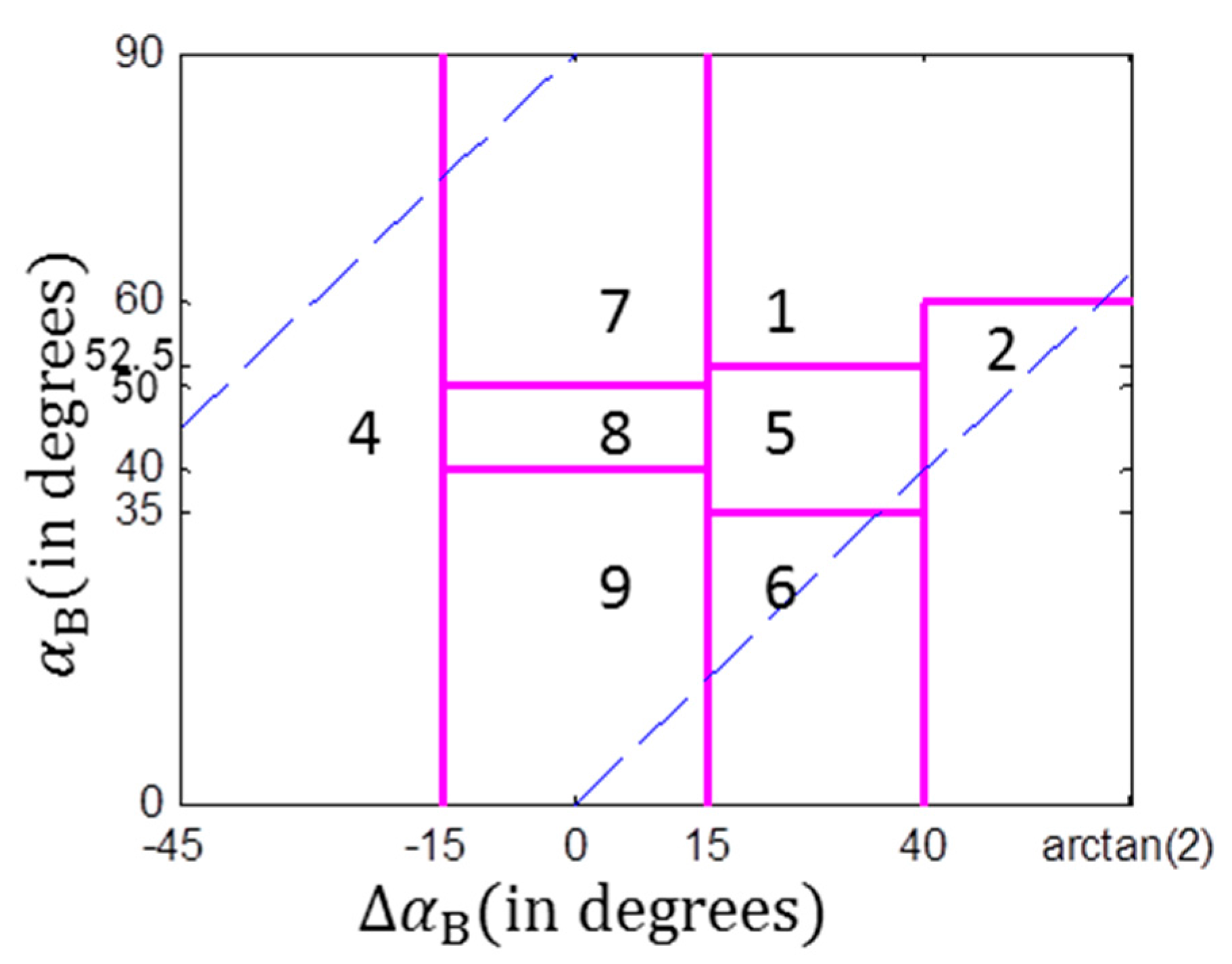
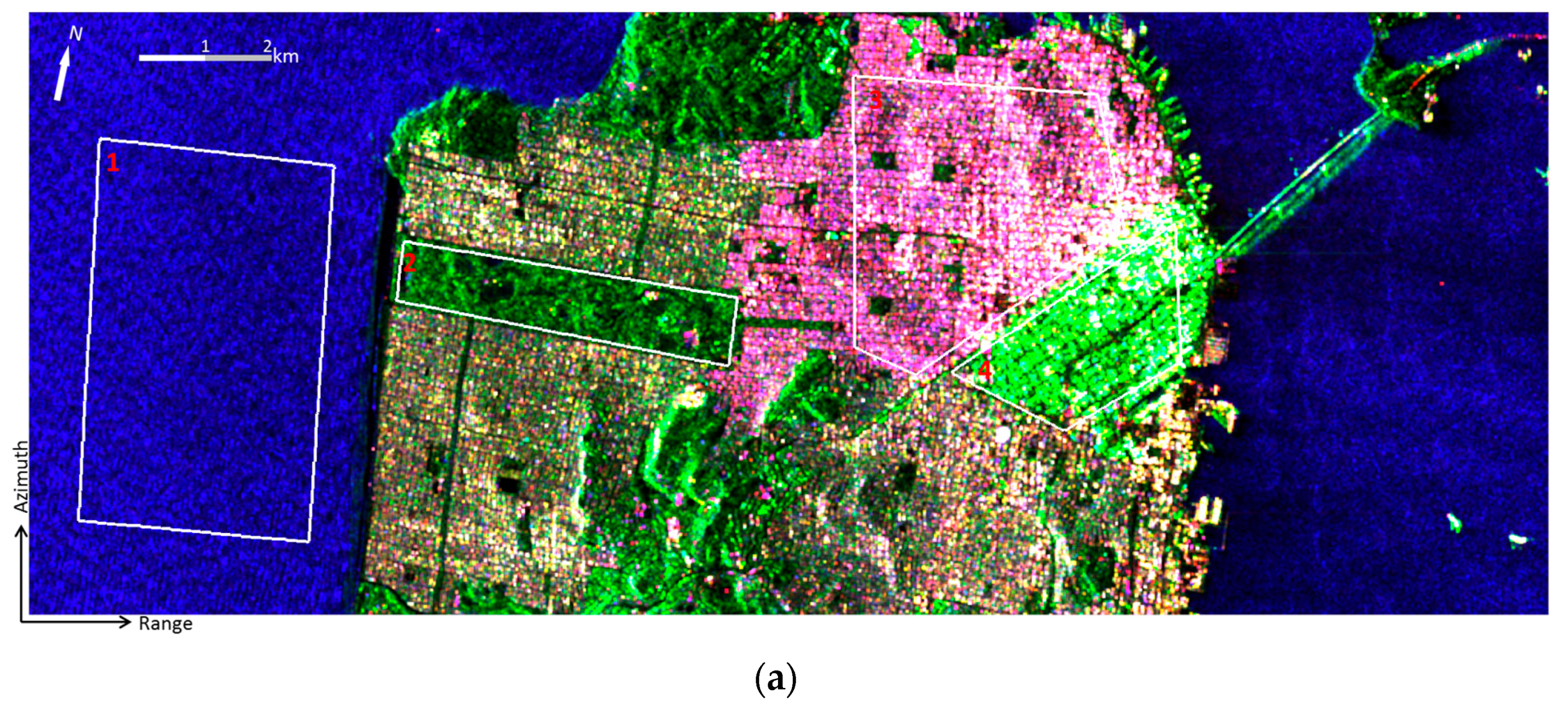
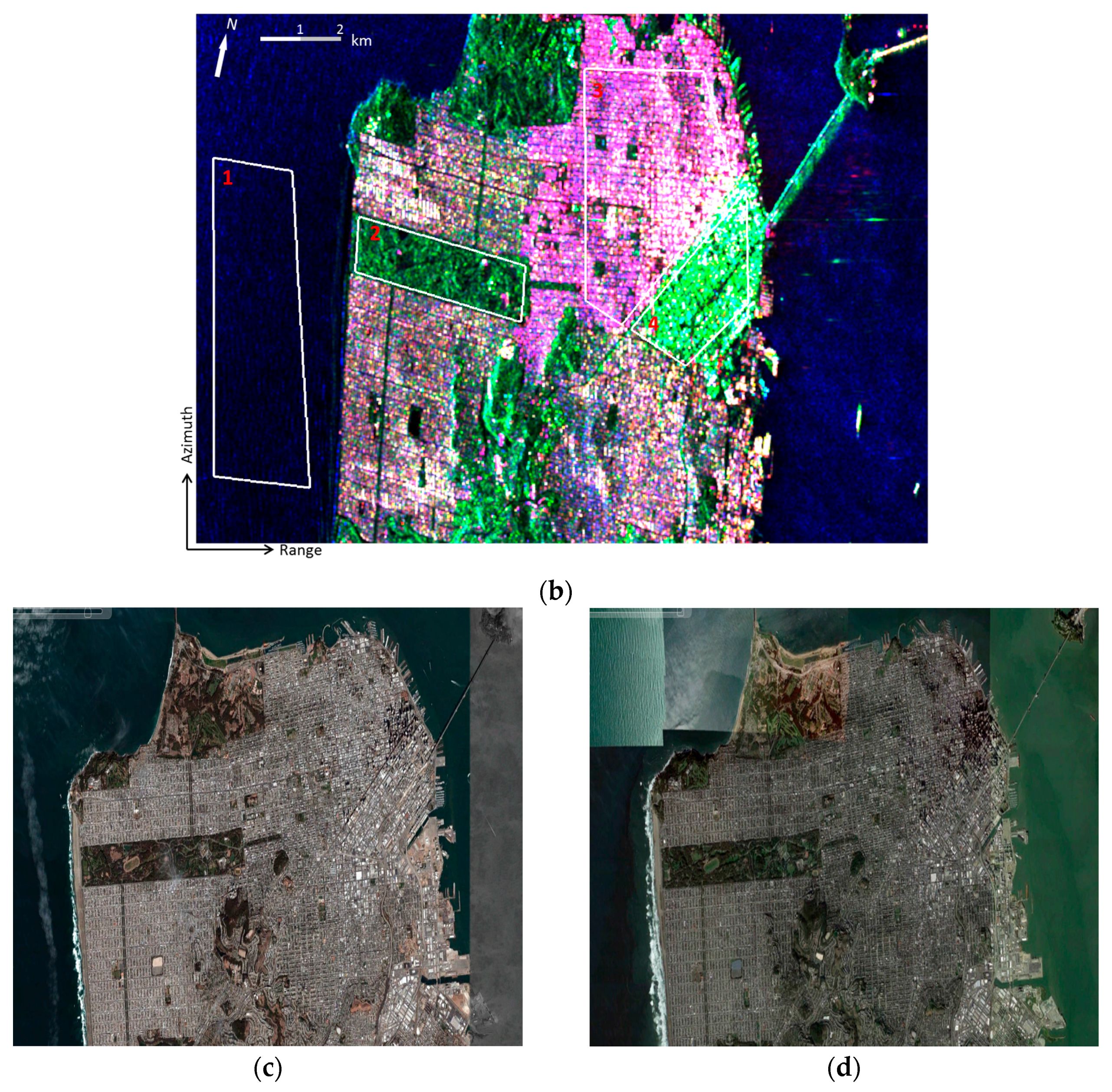
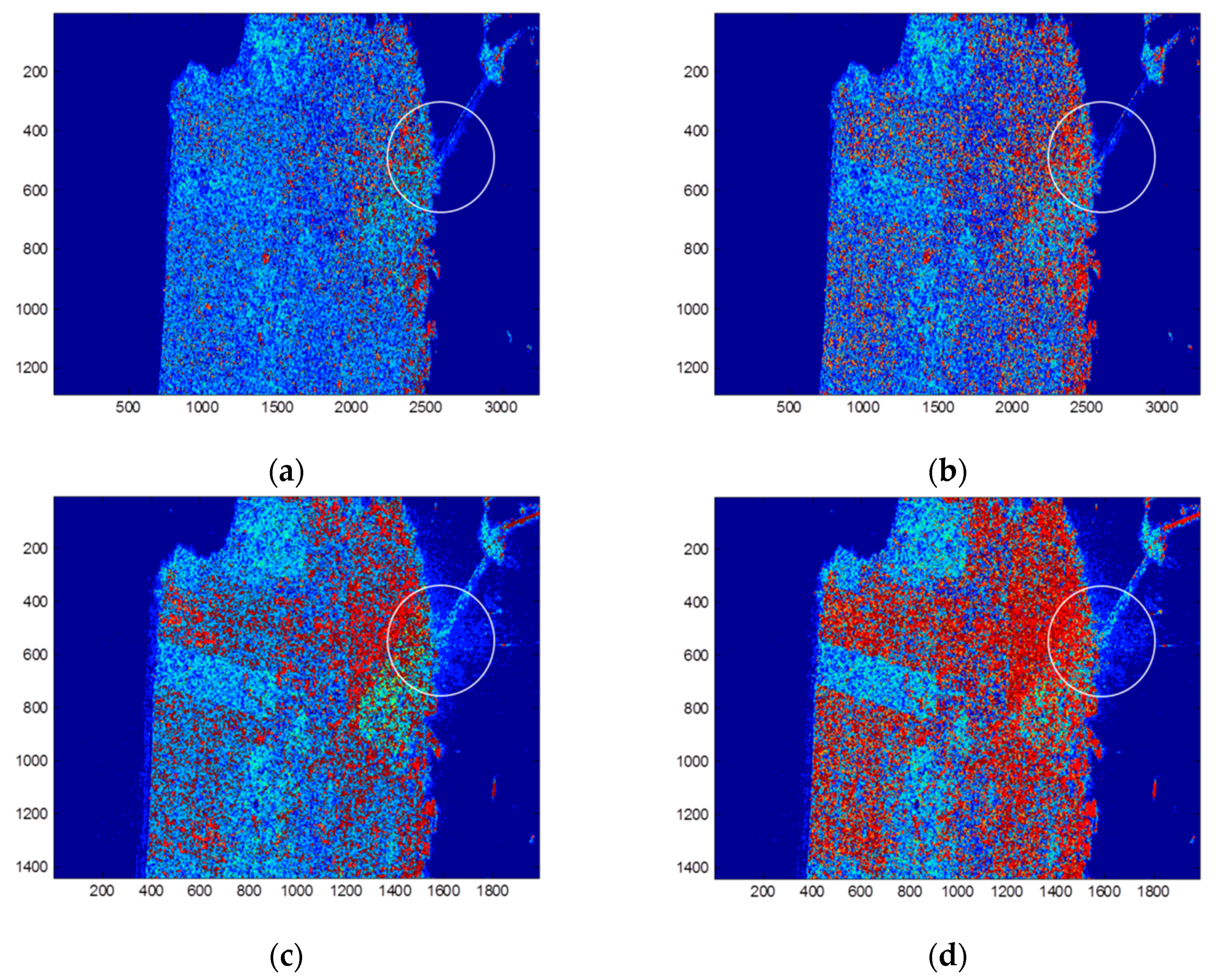
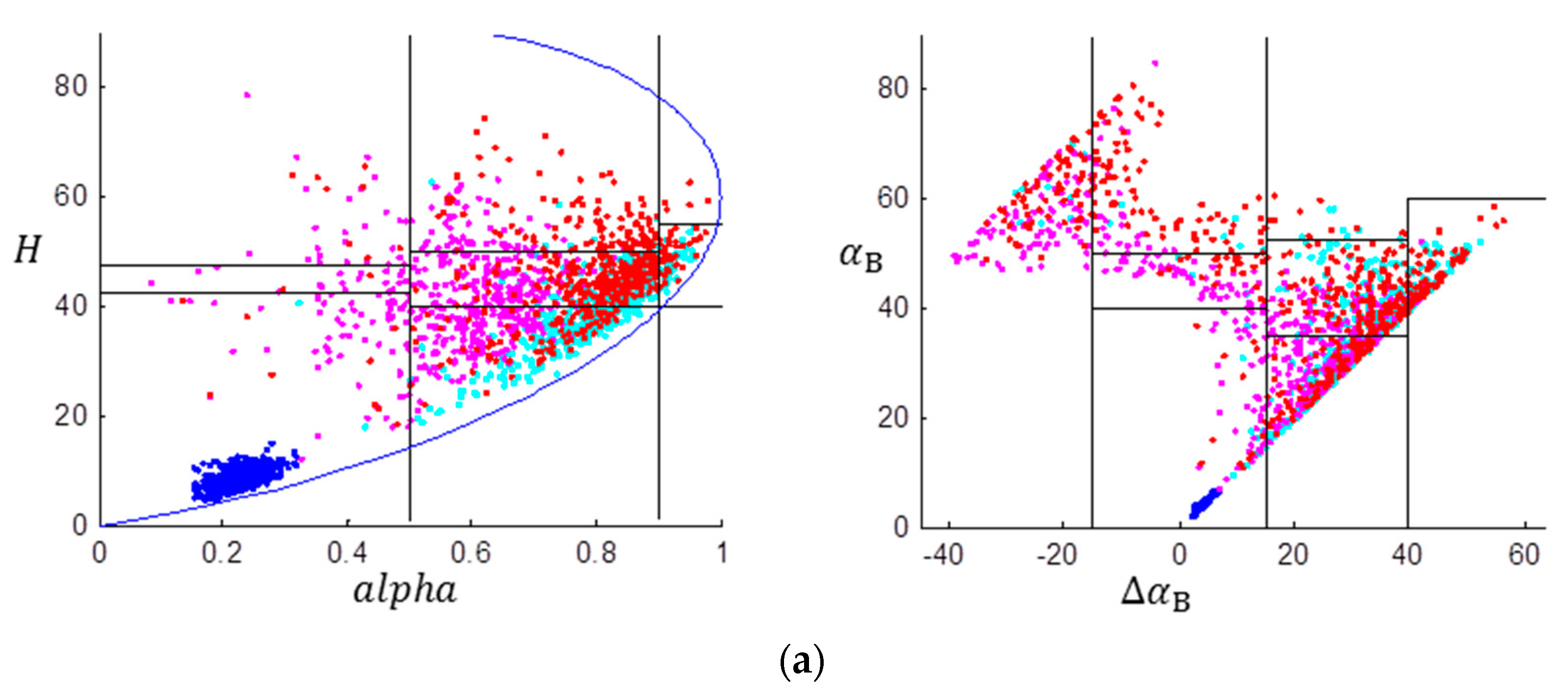
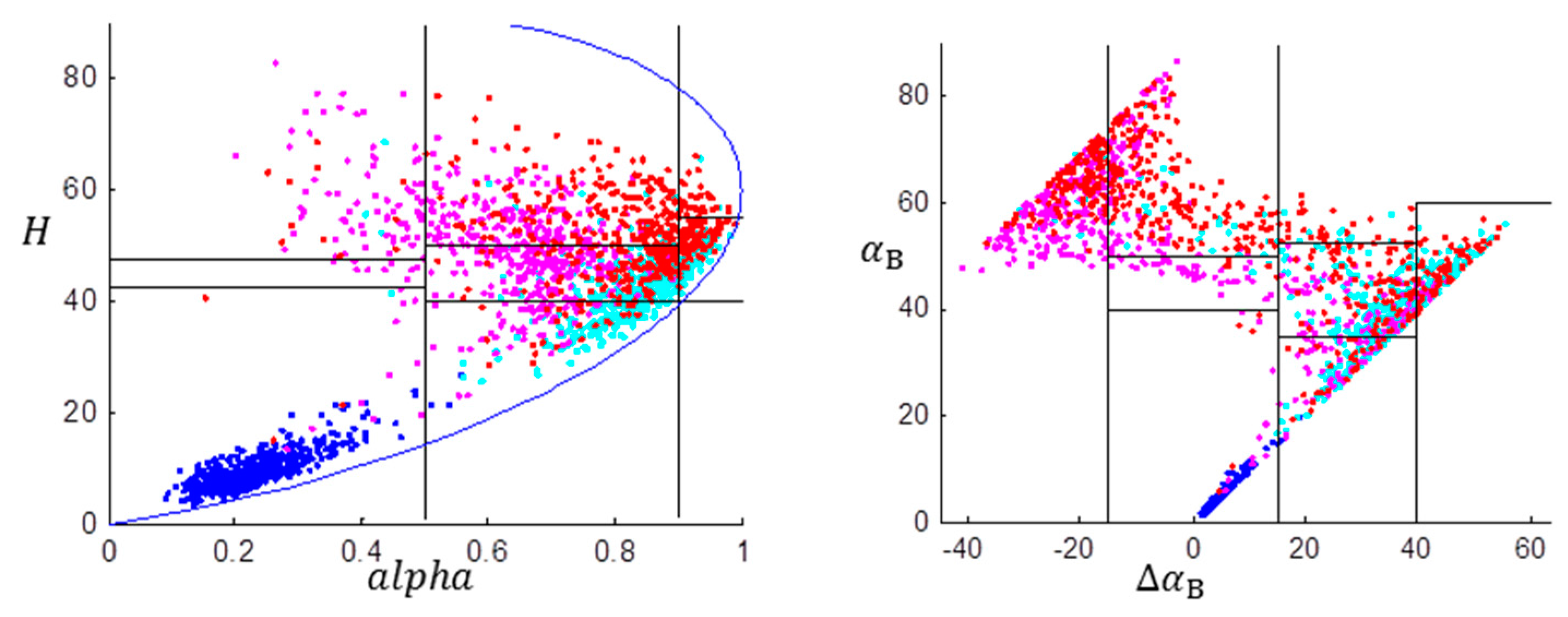
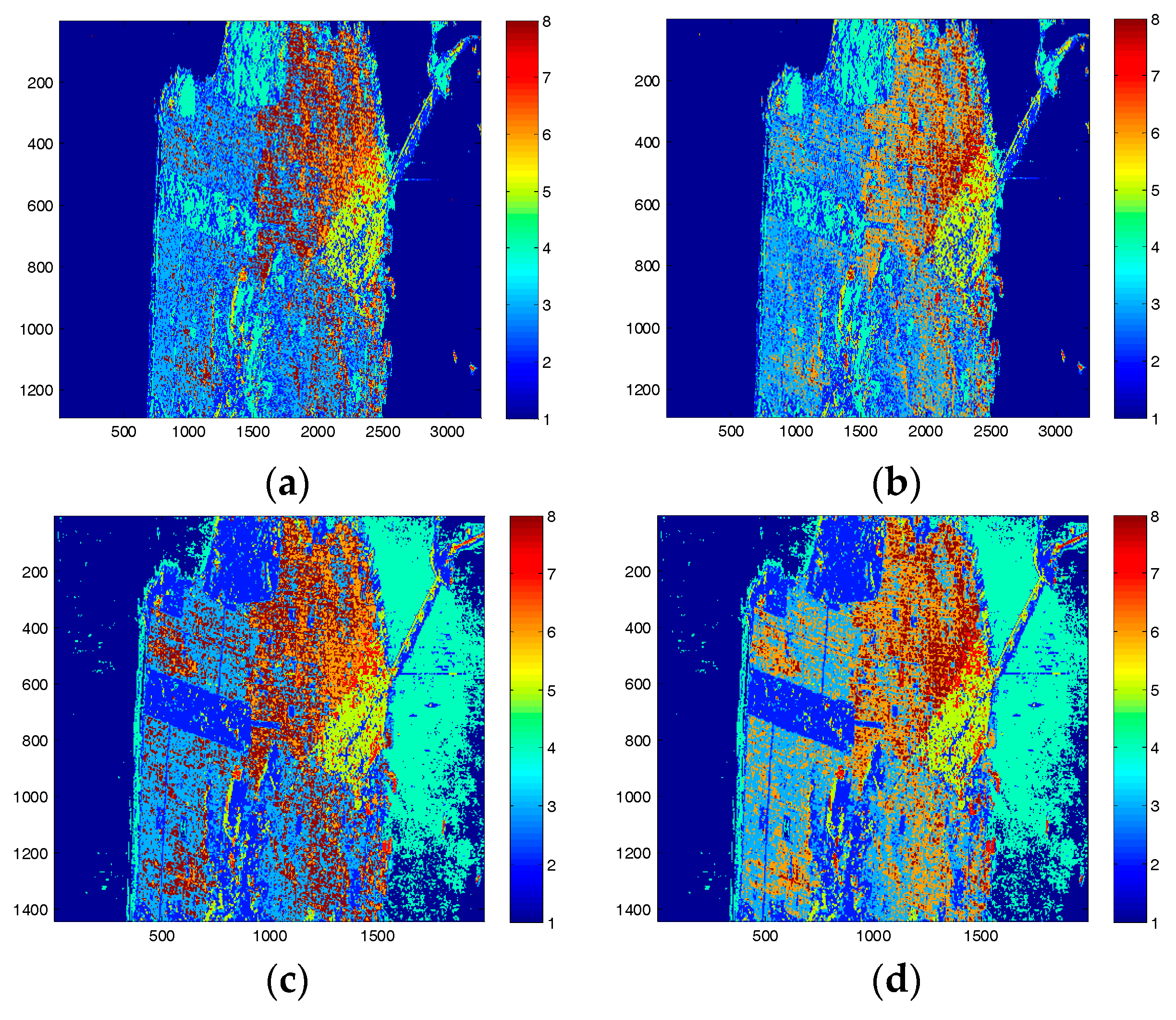
| (A) Results by Using the GF-3 Data | ||||||||||
| The Method | ||||||||||
| % | CA | Overall Accuracy | ||||||||
| Ocean | 100 | 0 | 0 | 0 | 0 | 0 | 0 | 0 | 100 | 59.47 |
| Forest | 1.00 | 46.33 | 40.86 | 8.90 | 0.11 | 0.03 | 0.26 | 2.51 | 49.76 | |
| Urban | 12.32 | 27.93 | 38.20 | 0.04 | 0 | 5.07 | 4.96 | 11.48 | 16.44 | |
| Tilted Urban | 2.35 | 17.23 | 44.30 | 8.89 | 1.40 | 0.35 | 1.45 | 24.03 | 25.48 | |
| The Method | ||||||||||
| % | CA | Overall Accuracy | ||||||||
| Ocean | 100 | 0 | 0 | 0 | 0 | 0 | 0 | 0 | 100 | 62.58 |
| Forest | 1.74 | 44.50 | 35.81 | 12.54 | 1.09 | 0.54 | 2.21 | 1.58 | 48.35 | |
| Urban | 8.06 | 30.85 | 22.54 | 0.95 | 0.02 | 13.03 | 5.71 | 18.84 | 24.55 | |
| Tilted Urban | 2.96 | 16.78 | 32.10 | 11.29 | 2.77 | 2.39 | 17.32 | 14.40 | 31.72 | |
| (B) Results by Using the Radarsat-2 Data | ||||||||||
| The Method | ||||||||||
| % | CA | Overall Accuracy | ||||||||
| Ocean | 99.87 | 0.13 | 0 | 0 | 0 | 0 | 0 | 0 | 99.87 | 69.90 |
| Forest | 0.17 | 29.28 | 49.95 | 14.94 | 0.35 | 0.08 | 0.30 | 4.93 | 64.89 | |
| Urban | 1.62 | 10.67 | 35.65 | 0.22 | 0.04 | 1.03 | 14.30 | 36.45 | 50.76 | |
| Tilted Urban | 0.83 | 4.81 | 26.70 | 16.54 | 7.18 | 0.23 | 3.19 | 40.51 | 43.71 | |
| The Method | ||||||||||
| % | CA | Overall Accuracy | ||||||||
| Ocean | 99.93 | 0.07 | 0 | 0 | 0 | 0 | 0 | 0 | 99.93 | 75.22 |
| Forest | 0.31 | 28.40 | 42.38 | 19.20 | 1.93 | 0.67 | 3.88 | 3.24 | 61.59 | |
| Urban | 2.04 | 10.15 | 14.92 | 1.59 | 0.07 | 9.74 | 18.90 | 42.59 | 61.49 | |
| Tilted Urban | 1.06 | 4.66 | 18.45 | 11.62 | 5.83 | 1.32 | 32.49 | 24.59 | 57.07 | |
| Ocean | Forest | Urban | Tilted Urban | ||
|---|---|---|---|---|---|
| The GF-3 data | 0.22 ± 0.00 | 0.80 ± 0.01 | 0.57 ± 0.02 | 0.78 ± 0.02 | |
| The Radarsat-2 data | 0.23 ± 0.00 | 0.83 ± 0.01 | 0.62 ± 0.02 | 0.81 ± 0.02 | |
| The GF-3 data | 8.77 ± 1.94 | 40.07 ± 6.78 | 42.25 ± 8.37 | 46.46 ± 8.40 | |
| The Radarsat-2 data | 9.93 ± 3.06 | 42.94 ± 5.87 | 50.00 ± 9.43 | 51.87 ± 7.67 | |
| The GF-3 data | 3.95 ± 0.93 | 29.60 ± 11.36 | 9.82 ± 20.55 | 16.72 ± 22.28 | |
| The Radarsat-2 data | 4.00 ± 1.84 | 30.56 ± 14.20 | -3.82 ± 22.00 | 7.06 ± 24.42 | |
| The GF-3 data | 4.19 ± 0.97 | 36.22 ± 8.84 | 41.20 ± 12.25 | 46.60 ± 12.41 | |
| The Radarsat-2 data | 4.39 ± 1.93 | 40.41 ± 9.32 | 52.77 ± 14.39 | 55.75 ± 12.29 | |
| % | Ocean | Forest | Urban | Tilted Urban | Others | Overall Accuracy | |
|---|---|---|---|---|---|---|---|
| (GF-3 data) -Wishart | Ocean | 100 | 0 | 0 | 0 | 0 | 84.29 |
| Forest | 0.25 | 96.48 | 0.90 | 1.08 | 1.29 | ||
| Urban | 0.01 | 7.01 | 66.92 | 0.40 | 25.66 | ||
| Tilted urban | 0 | 29.33 | 3.04 | 58.53 | 9.11 | ||
| (GF-3 data) -Wishart | Water | 100 | 0 | 0 | 0 | 0 | 85.23 |
| Field | 0.25 | 96.47 | 0.91 | 1.09 | 1.28 | ||
| Forest | 0.01 | 7.00 | 67.10 | 0.40 | 25.49 | ||
| Urban | 0 | 27.27 | 3.04 | 60.56 | 9.13 | ||
| (Radarsat-2 data) -Wishart | Water | 99.16 | 0 | 0 | 0 | 0.84 | 84.98 |
| Field | 0.07 | 88.96 | 1.01 | 4.31 | 5.65 | ||
| Forest | 0 | 2.42 | 75.96 | 0.76 | 20.28 | ||
| Urban | 0 | 14.06 | 3.51 | 66.14 | 16.29 | ||
| (Radarsat-2 data) -Wishart | Water | 99.18 | 0 | 0 | 0 | 0.82 | 85.27 |
| Field | 0.07 | 88.65 | 1.04 | 4.31 | 5.92 | ||
| Forest | 0 | 2.32 | 76.82 | 0.76 | 20.11 | ||
| Urban | 0 | 13.83 | 3.54 | 66.17 | 16.46 |
© 2017 by the authors. Licensee MDPI, Basel, Switzerland. This article is an open access article distributed under the terms and conditions of the Creative Commons Attribution (CC BY) license (http://creativecommons.org/licenses/by/4.0/).
Share and Cite
Yin, J.; Yang, J.; Zhang, Q. Assessment of GF-3 Polarimetric SAR Data for Physical Scattering Mechanism Analysis and Terrain Classification. Sensors 2017, 17, 2785. https://doi.org/10.3390/s17122785
Yin J, Yang J, Zhang Q. Assessment of GF-3 Polarimetric SAR Data for Physical Scattering Mechanism Analysis and Terrain Classification. Sensors. 2017; 17(12):2785. https://doi.org/10.3390/s17122785
Chicago/Turabian StyleYin, Junjun, Jian Yang, and Qingjun Zhang. 2017. "Assessment of GF-3 Polarimetric SAR Data for Physical Scattering Mechanism Analysis and Terrain Classification" Sensors 17, no. 12: 2785. https://doi.org/10.3390/s17122785





